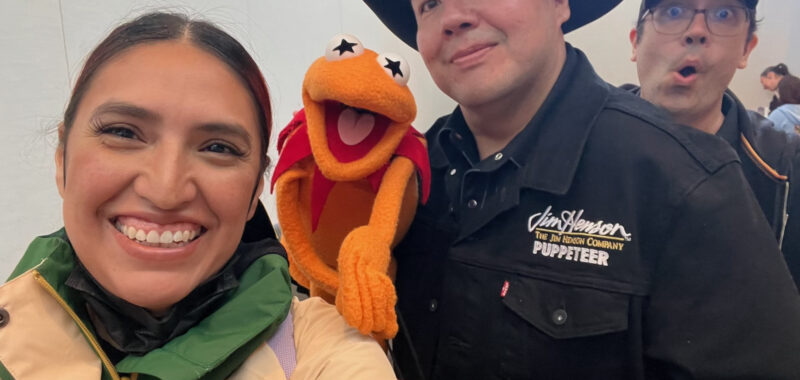OKLAHOMA CITY, Oklahoma — Let’s talk puppets! The transformative process of crafting and bringing an inanimate object to life is one of our most ancient forms of storytelling, and has been documented in communities like the Maya, Toltec, Navajo, and Hopi from as early as the 16th century. Puppetry continues to be a vibrant form of storytelling in Indigenous communities.
This year marked the inaugural convening of the Indigenous Puppetry Institute at the First Americans Museum in Oklahoma City. Inspired by the number of Native folks he met at various Comic Con and Sci-fi conventions, Dr. Lee Francis (Pueblo of Laguna) founded IndigiPopX in 2016 to bring together Indigenous artists and enthusiasts of comics, science fiction, and other pop culture. Buoyed by the success of that event, Francis turned toward the project of cultivating a space for contemporary Indigenous puppeteers to meet.
“Many of us thought we were alone,” Candice Byrd-Boney (Quapaw/Osage/Cherokee Nations) told Hyperallergic. “And we are not! This is why spaces like these are so important, especially for us. We’re often not the majority in the room, which means it’s often not a safe space to share.”

During the two-day Puppetry Institute this past spring, many Indigenous practitioners shared practices that ranged from marionette, shadow, and tabletop puppetry to theater, film, music videos, and street performances. There were formal workshops such as cosplay mask-making, as well as informal peer-to-peer sharing during meals. Workshops were often led by guest lecturers such as Tarish Pipkins, aka Jeghetto. A self-described “puppet engineer,” he showcased the complex and fluid movement of his creations, including pulleys and levers. Puppeteers gathered around his cardboard T-Rex marionette and took turns learning how to best maneuver it into performing natural gestures and walking.
Some practitioners, such as DerRic Starlight, traveled across the country with a suitcase full of puppets (or, in his case, “Nuppets,” short for “part Native and part puppet”) to attend. When he was growing up on the Tsuut’ina First Nation Reserve near Calgary, Alberta, Starlight shared, it was his dream to get to Sesame Street and perform his own puppet shows for his classmates. On top of a career in professional wrestling, he still managed to maintain his practice and found his way to his current position puppeteering for the Apple+ relaunch series, Fraggle Rock (2022–ongoing). His blend of humor and vulnerability, as he shared his personal story of puppetry, had the circle of participants laughing and crying.

Many of the puppeteers have backgrounds in interdisciplinary arts, but each had a unique journey. Graci Horne (Sisseton Wahpeton & Hunkpapa Lakota/Dakota people), for instance, is a multi-disciplinary artist-teacher with a degree in museum studies. At the Institute, she prompted conversations about the preservation and protection of Indigenous puppetry. Horne discussed how important it is, when sharing oral or traditional stories within the puppet community, to communicate and establish that it is not for others/non-Natives to take, capitalize on, or share as their own.
The Indian Arts and Crafts Act and the Native American Graves Protection and Repatriation Act of 1990 were passed to safeguard Indigenous communities and arts, but puppetry isn’t a craft listed in many of those legal protections. At the Institute, puppeteers shared strategies and stories of how they have and continue to navigate the art in and outside their communities under those circumstances. Local Oklahoma Osage puppeteers from the Wahzhazhe Puppet Theatre such as Candice Byrd-Boney, for instance, shared the experience of working with their tribe and community to develop community engagement with an Indigenous-centered and -led approach. For Byrd-Boney, “Puppetry is an expansive conduit and multisensory experience for everyone, not just kids.”
Co-organizer Kaley Morrison (Waccamaw Siouan), a comedic performer and artist, added that it is not only the law that fails Indigenous puppeteers but also other spaces. “A lot of arts institutions don’t feel welcoming or can be performative,” she said. “So it is important to me to help create space for Indigenous puppeteers, and not just be asked to come out during the month of November.” (November is National Native American Heritage Month in the United States.)


Morrison set up the “Building a Puppet” workshop on the last day of the Insititute, which led into the Indigenous Puppetry Institute finale — a parade throughout the First Americans Museum. Marching with puppets that were shared, brought from home, or made in a workshop, the parade roamed to the beat of a drum circle.
The procession included Pipkins’s prehistoric cardboard marionette T-Rex, a giant bat, buffalo, Mesoamerican serpent, whooping crane, and other imagined creatures. Smiles, laughs, and joy followed the parade; elders and children alike cheered, charmed by the unexpectedness and imagination of the artists’ creations. I felt the shared belief amongst the audience of the power of puppetry.



Often, finances and travel fees can pose challenges for Indigenous communities trying to come together. Nearly every person I interviewed expressed gratitude to the Green Feather Foundation, a non-profit focusing on puppetry and arts, and its leader Heather Henson in particular, for their sponsorship of the Indigenous Puppet Institute’s first iteration and many participants’ travel. “Native voices, we noticed, are a particular challenge within our puppet communities. We knew the historical traditions and current artists were out there, but we weren’t sure the best way to find and support them,” Producer and General Manager Brenna Ross told Hyperallergic. “We were blown away by the community of artists and educators who came together and invigorated by the ideas that arose for future gatherings.”
This first Puppetry Institute generated many connections, expanding networks that focus on spreading various styles and furthering the work of preserving one of our most ancient art forms of storytelling. “[Puppeteering] goes into the roots of how we weave stories and objects, how we synthesize our philosophies and ontologies, in a way that allows us to tell stories differently,” Francis explained.“It is character-building and brought to life with a new form of dynamic storytelling.”

